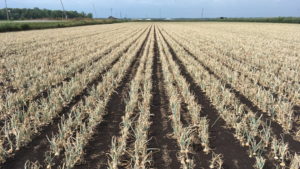CALS Team Promotes Adoption of Onion IPM Program to Fight Pests, Cut Chemical Sprays
The value of the onion crop in New York state is between $40 and $50 million annually, but that figure is threatened by the predation of onion thrips. Onions are a high value vegetable crop that can only be grown on specific nutrient-rich soils, with the potential to make a grower up to $6,000 per acre. However, they are plagued with pest and pathogen pressure, and pest-induced yield loss can be severe.
The common practice of spraying insecticides regularly at predetermined times can lead to waste of chemicals and labor time if the spray treatment was not absolutely necessary at the time; i.e. the pest damage has not passed the action threshold, as well as non-target environmental and human health effects. A team was assembled to address this problem: Brian Nault, a Cornell entomologist responsible for the development of low-toxicity high-efficacy chemical insecticides that are pervasive throughout nearly all New York state onion farmers; Ph.D. student Ashley Leach; and long-time CCE vegetable extension specialist Christy Hoepting. This group developed and studied the efficacy of an integrated pest management (IPM) program that utilized a rotation of insecticide sprays and set action thresholds to prevent unnecessary applications and thwart the development of pest resistance.
The team recognized that change in agricultural practices is grower-driven. An integrated pest management program cannot be deemed successful simply because it has been developed. Individual growers much choose that it is in their benefit to adopt. The team’s extension-focused work in promoting the program proved effective, with adoption of IPM practices increasing about 25 percent in targeted areas. Many NYS growers changed their practices, and in the third year growers were decreasing insecticide applications between 12 and15 percent, saving an average of $148 per acre.
The study, titled “Grower adoption of insecticide resistance management practices increase with extension-based program,” was published in the February 2019 issue of Pest Management Science. You can read more about this program and associated research in the Cornell Chronicle.


